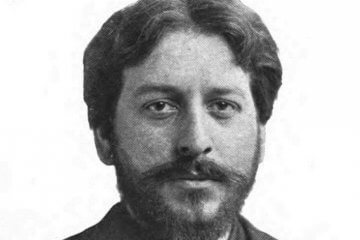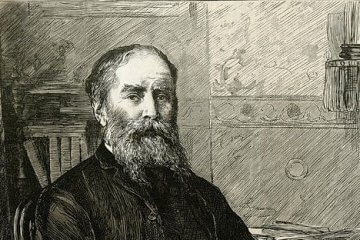I stepped out of the fine arts building on a breezy spring afternoon to lead my fifth grade class back to our classroom in St. Patrick Cottage. It was one of those lovely Kentucky early spring days at Highlands Latin School that winter daydreams are made of when you expect to shiver, but the sunshine gently warms your whole body from your head to your toes. In a few more weeks the pink dogwoods would bloom and the tulips would pop up all over campus, but that day the smell of freshness and the expectation of warmer, brighter days hung in the air. The breeze swirled the folds of my dress as we walked quietly in line down the sidewalk, and all that was heard was the sound of little feet, the rustling of the wind through the trees, and birds chirping. One bird in particular was relentlessly boisterous with his long, shrill one-pitched song and clearly closeby. I motioned for the class to stop and listen. We could not see the bird, but little hands shot up with excited, smiling faces as the students stood patiently waiting for me to call on them. “Who can tell me whose loud song that is?” I asked. “It’s the blue jay!” said Max. “That’s right! Excellent. Let’s see if we can see him.” We waited under the shade of the dogwood listening for more shrill “jaaay” calls and sure enough, the radiant blue beauty hopped out between the leaves of the nearby tree to say hello.
This was a delightful, weekly occurrence for our class. We heard the terrifying descending “cheeeewv” of the red-tailed hawk; we saw a murder of crows foraging for seeds in the field; we were entertained by the silly resounding “h-ronk” of the Canada Geese feasting on the grass outside our classroom window; and we marveled at the song sparrow’s nest nestled in the overhang of the front office.
So why study birds? I’ll give you three reasons the study of birds is valuable in classical Christian education. It teaches students to appreciate the world around them; it has played an important role in Western Civilization; and it develops the virtue of faith.
The study of birds teaches students to appreciate the world around them. In our curriculum, we study the natural world in the primary and grammar years to teach students about their environment and give them an appreciation for the world God created. We focus on teaching one subject deeply like mammals, astronomy, insects, birds, and trees, instead of many subjects broadly. This mastery approach immerses the students in their material world and cultivates confidence in the subject enhancing their ability to learn and retain something valuable. When students get to the more complex subjects of biology, chemistry, and physics, they are then also able to master those.
Mastery in the subject of birds for the grammar stage includes a general knowledge of birds. In studying birds, students learn the anatomy and physiology of birds and master the thirty-one most common birds in North America. They are then able to identify the majority of birds they see around them by sight and sound. As I mentioned, I saw first hand the wonder, beauty, and confidence this brought into my students lives. God intricately created birds, from their ability to build thimble-sized nests fastened from soft dandelion and spider silk by the Ruby-throated Hummingbird, to the long, protruding tongue of the Downy Woodpecker that internally wraps around its brain, to the steep-diving courtship displays of the Red-tailed Hawk.
I saw first hand the wonder, beauty, and confidence the study of birds brought into my students lives.
The study of birds has played an important role throughout Western Civilization. Birds are in mythology, like Huginn and Muninn, the ravens of Norse mythology that flew around the world as secret informants for Odin, father of Thor. Aphrodite (or Venus), sometimes known as the Divine Lady of the Doves, rode a chariot drawn by doves. In history, falconry and hawking, training a falcon or hawk to hunt prey, was a favorite pastime of the royalty of the Middle Ages, from Henry the Fowler, to Edward the Confessor, to Henry III. And in literature, the shape-shifting witch in Robin Hood, Mother Maudlin, is first seen in the form of a raven, in Jane Eyre, bird imagery throughout the novel symbolizes Jane’s transformation from caged to freed, and in Macbeth, the raven is an omen foreshadowing the death of King Duncan. By studying birds, students are able to appreciate how the uniqueness of different birds have shaped the stories that people have told.
The study of birds develops the virtue of faith. In the Christian tradition, birds have been used to symbolize God’s care for his people. Birds were created by God on the fifth day. Isaiah paints imagery of the Lord carrying his people on eagle’s wings (Isaiah 40:31) to comfort and renew their strength. Psalms says that He knows “every bird in the mountains” (Psalm 50:11). In his famous Sermon on the Mount, Jesus tells us to “consider the ravens” (Luke 12:24). If the Lord created, knows, and cares deeply about the birds, then he certainly created, knows, and cares even more deeply for us.
The study of birds also cultivates faith in our caring Creator. Hebrews 11:1 says that “faith is the substance of things hoped for and the evidence of things unseen.” St. Thomas Aquinas defines the virtue of faith as “a habit of the mind, whereby eternal life is begun in us, making the intellect assent to what is non-apparent” (Summa Theologicae). Studying birds gives evidence that God, who is unseen, is real. It develops the virtue of faith. By studying birds which are seen, we learn more about the creator who is unseen.
If the Lord created, knows, and cares deeply about the birds, then he certainly created, knows, and cares even more deeply for us.
In the age of the internet, that old English proverb remains true: “One bird in the hand is worth two in the bush.” The knowledge of nature that we store in our hearts and minds is worth far more than the details we can google, but then immediately forget. You could look up that funny-looking bird outside of your kitchen window, his song, and how he flies. But, if you studied the Book of Birds, you would instantly recognize him by the tell-tale black “cap” on his head, black “bib” on his chest, and his cheery “feebee” song. You would know the purpose of the varieties of his feathers in flight as well as the complex system of air sacs in his lungs that promotes lift and powers of flight. Mastery of the basics of birds is valuable in classical Christian education.



4 Comments
Sarah Jo Davis · September 18, 2020 at 10:18 am
Thank you, Brent! I completely agree.
Brent Butts · September 17, 2020 at 11:06 pm
I really enjoyed this article. I’ve always admired God’s creations, especially birds. We can learn so much by taking time to appreciate God’s creatures.
Sarah Jo Davis · September 17, 2020 at 3:15 pm
Thank you so much! I’m glad you enjoyed the article.
Juanita · September 17, 2020 at 2:50 pm
Love this article…the descriptors of sight and sound of birds, and why study of birds is interesting —world around us is interesting and the correlation on learning. And the virtue of faith and Gods care related to scripture. Extremely well written and “real life” relationships.